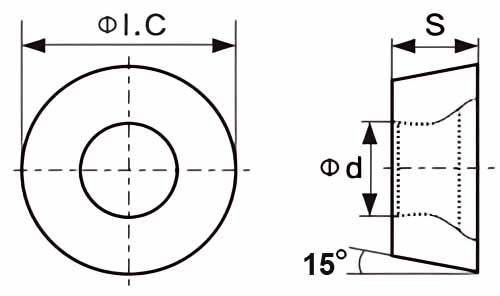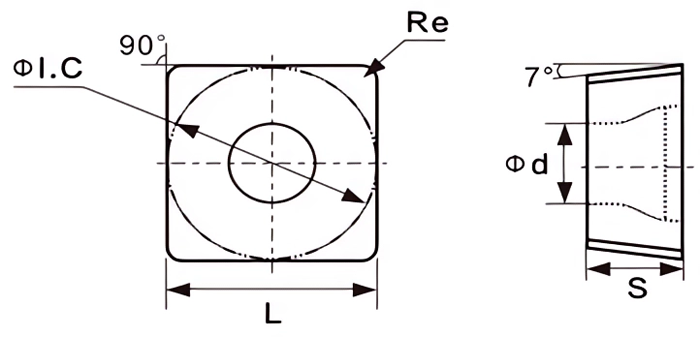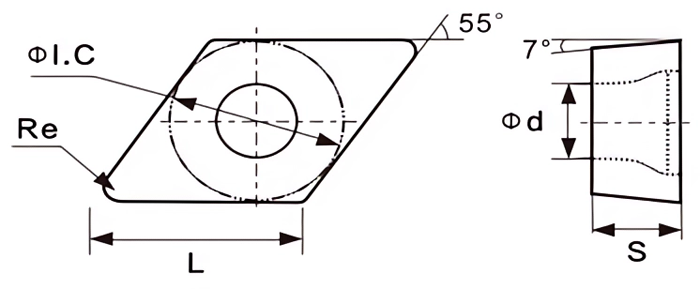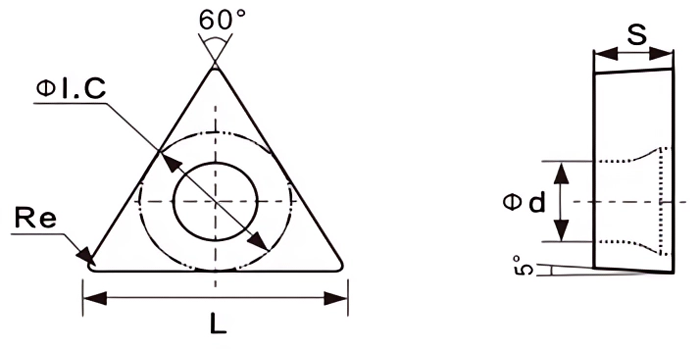Введение: Основа эффективного токарного производства
В мире механической обработки, токарная обработка вставки это рабочие лошадки, придающие форму и точность цилиндрическим заготовкам, обеспечивающие эффективность и точность в различных отраслях промышленности. Эти универсальные режущие инструменты, как правило, изготовленные из карбида вольфрама, необходимы для выполнения широкого спектра токарных операций, от черновой до чистовой обработки. В этом подробном руководстве подробно рассматриваются токарные пластины общего назначения, их типы, области применения, критерии выбора и ключевые моменты для достижения оптимальной производительности обработки.
Понимание токарных вставок общего назначения: Что это такое?
Определение режущего инструмента:
A токарная вставка общего назначения это прецизионный режущий инструмент, предназначенный для токарных работ, обычно удерживаемый в резцедержателе, установленном на токарном станке. Эти пластины имеют несколько режущих кромок, что позволяет при необходимости переходить на новую кромку, максимально увеличивая срок службы инструмента и сводя к минимуму время простоя. Они специально разработаны для снятия материала с наружного диаметра вращающихся заготовок, создания цилиндрических форм, заплечиков, канавок и других элементов.
Основные преимущества токарных пластин общего назначения:
- Исключительная твердость и износостойкость: Токарные пластины общего назначения обычно изготавливаются из карбида вольфрама - композитного материала, известного своей твердостью, и выдерживают высокие температуры и усилия, возникающие в процессе обработки, обеспечивая длительный срок службы инструмента и стабильную производительность.
- Индексируемая конструкция для максимального использования инструмента: Множество режущих кромок на одной пластине обеспечивают возможность индексации, максимально продлевая срок использования пластины до замены. Такая конструкция снижает затраты на инструмент и минимизирует время простоя, связанное с его заменой.
- Универсальность токарных работ: Токарные пластины общего назначения выпускаются в широком диапазоне геометрии, марок и покрытий, что делает их пригодными для различных токарных операций, включая черновую, получистовую и чистовую обработку, для широкого спектра материалов.
- Экономичность и эффективность: Сочетание увеличенного срока службы инструмента, универсальности и высоких скоростей резания, предлагаемых токарными пластинами общего назначения, способствует повышению эффективности обработки и снижению общих производственных затрат.
Углубляясь: Типы, геометрии и градации
Мир выбора:
Токарные пластины общего назначения выпускаются различных типов, каждый из которых оптимизирован для конкретных материалов и операций обработки. К числу распространенных типов относятся:
- Вставки с CVD-покрытием: Благодаря тонкому твердому покрытию, нанесенному методом химического осаждения из паровой фазы (CVD), эти пластины обладают превосходной износостойкостью, что делает их пригодными для высокоскоростной обработки и сложных условий эксплуатации.
- Вставки с PVD-покрытием: Используя метод физического осаждения из паровой фазы (PVD), эти пластины имеют более тонкое и ровное покрытие, часто с более низкой температурой резки, что делает их подходящими для задач, требующих более острых кромок и улучшенной обработки поверхности.
- Вставки из кермета: Состоящие из металлокерамического композита, эти пластины обладают высокой твердостью и износостойкостью, особенно при повышенных температурах, что делает их пригодными для обработки закаленных сталей и других труднообрабатываемых материалов.
- Вставки CBN: Пластины из кубического нитрида бора (CBN) обладают исключительной твердостью и износостойкостью, уступая лишь алмазу, что делает их идеальными для обработки закаленных сталей, чугуна и других абразивных материалов.
Расшифровка геометрии вставки: Формирование разреза
Геометрия пластин, включая углы наклона, углы зазора и стружколомы, играет решающую роль в образовании стружки, отводе стружки и чистоте поверхности.
- Угол наклона: Угол между граблиной пластины и линией, перпендикулярной поверхности заготовки. Положительные углы ракеля уменьшают силу резания и создают более тонкую стружку, а отрицательные углы ракеля увеличивают прочность кромки и улучшают контроль стружки.
- Угол зазора: Угол между зазорной поверхностью пластины и касательной к поверхности заготовки в точке резания. Достаточный угол зазора предотвращает трение между пластиной и заготовкой, снижая тепловыделение и износ инструмента.
- Чипбрейкер: Канавка или углубление на ракельной поверхности пластины, которое контролирует образование стружки и направляет поток стружки от зоны резания, предотвращая ее накопление и улучшая качество обработки поверхности. Для различных материалов и требований к контролю стружки предлагаются различные стили стружколомателей.
Общие формы токарных вставок:
Токарные пластины общего назначения бывают разных форм, каждая из которых предназначена для определенных операций резания и геометрии заготовки. Вот некоторые из наиболее распространенных форм:
- Круглые вставки (S-образная форма): Круглые пластины с прочной режущей кромкой и хорошим отводом стружки универсальны и подходят для непрерывной резки, особенно для обработки криволинейных поверхностей и профилирования.
- Квадратные вставки (S-образная форма): Обеспечивая прямую режущую кромку и хорошую шероховатость поверхности, квадратные пластины обычно используются для торцевания, обработки уступов и токарных работ, требующих высокой точности.
- Треугольные вставки (Т-образная форма): Треугольные пластины с тремя режущими кромками обеспечивают хороший отвод стружки и обычно используются для токарной обработки в средних и тяжелых условиях, особенно для прерывистого резания и черновой обработки.
- Алмазные вставки (форма D): Благодаря острым режущим кромкам и способности выдерживать высокие скорости подачи алмазные пластины часто используются для финишной обработки, обеспечивая превосходную чистоту поверхности различных материалов.
- Прямоугольные вставки (форма R): Прямоугольные пластины с длинной прямой режущей кромкой подходят для тяжелых токарных работ, глубокого пазования и отрезки.




Понимание градации твердых сплавов: Система классификации ISO
Марки твердого сплава, классифицированные по системе Международной организации по стандартизации (ISO), обозначают конкретные свойства и области применения пластин из карбида вольфрама. Классификация ISO состоит из буквы (группа применения) и цифры (твердость и вязкость).
- Группы приложений:
- P: Для обработки стали, стальных отливок и материалов с длинным сколом.
- M: Для обработки нержавеющей стали, высокотемпературных сплавов и других труднообрабатываемых материалов.
- K: Для обработки чугуна, цветных металлов и неметаллических материалов.
- Твердость и прочность: Число, следующее за буквой, указывает на предел прочности при поперечном разрыве (TRS) в Н/мм² и твердость (HV). Более высокие цифры обычно указывают на большую твердость и износостойкость, но меньшую вязкость.
Применение в различных отраслях промышленности: Где точность сочетается с производительностью
Повышение эффективности в ключевых секторах:
Токарные пластины общего назначения являются незаменимыми инструментами в самых разных отраслях промышленности, включая:
- Автомобиль: Производство деталей двигателей, трансмиссий, осей и других ответственных узлов, требующих высокой точности и долговечности.
- Аэрокосмическая промышленность: Производство компонентов шасси, деталей двигателей, элементов конструкций и других деталей, требующих исключительной прочности и надежности.
- Производство медицинского оборудования: Создание имплантатов, хирургических инструментов и других медицинских изделий, требующих жестких допусков и биосовместимости.
- Энергия: Обработка компонентов для нефтегазовой разведки, производства электроэнергии и систем возобновляемых источников энергии, часто в экстремальных условиях.
- Общее производство: Широко используется в механических цехах, на заводах и производствах для выполнения различных токарных операций с широким спектром материалов.
Сравнение поставщиков: Навигация по рынку токарных пластин общего назначения
| Поставщик | Расположение | Диапазон цен (за вставку) | Специальности |
|---|---|---|---|
| Sandvik Coromant | Швеция | $8 – $50+ | Широкий ассортимент вставок для различных областей применения, современные покрытия и геометрия, известные своими инновациями и высокой производительностью. |
| Kennametal | США | $7 – $45+ | Высокопроизводительные пластины для сложных задач, инновационные решения для оснастки и ориентация на индивидуальные решения заказчика. |
| TRUER | Китай | $6 – $40+ | Разнообразные геометрии вставок, экономичные решения и сильный акцент на исследованиях и разработках, известные благодаря серии LOGIQ. |
| Инструменты Walter | Германия | $9 – $55+ | Широкий ассортимент пластин, систем оснастки и смазочно-охлаждающих жидкостей, ориентированных на точность, производительность и цифровые решения. |
Взвешивание плюсов и минусов: преимущества и ограничения
| Преимущества | Ограничения |
|---|---|
| Исключительная твердость и износостойкость | Более высокая первоначальная стоимость по сравнению с инструментами из быстрорежущей стали, но она компенсируется более длительным сроком службы инструмента |
| Индексируемая конструкция для максимального использования инструмента | Требуется специальная система держателей инструментов и надлежащий зажим |
| Широкий ассортимент марок, геометрий и покрытий для различных областей применения | Правильный выбор и применение имеют решающее значение для оптимальной производительности и срока службы инструмента |
| Высокие скорости резания и подачи для повышения производительности | Может быть хрупкой и склонной к сколам при ударных нагрузках или неправильном использовании |
Разница TRUER: Почему вы выбираете нас для изготовления токарных пластин общего назначения?
Сотрудничество с лидером в области передовых технологий:
- Бескомпромиссное качество: Мы поставляем наши токарные пластины общего назначения от известных производителей, обеспечивая неизменное качество, производительность и надежность для ваших самых сложных операций обработки.
- Экспертиза по конкретным приложениям: Наша команда опытных инженеров поможет вам выбрать оптимальные пластины для ваших конкретных потребностей в токарной обработке, учитывая материалы, операции, желаемые результаты и экономическую эффективность.
- Конкурентоспособные цены и своевременная доставка: Мы предлагаем конкурентоспособные цены и стремимся оперативно выполнять заказы, сводя к минимуму время простоя и повышая производительность. Наша цель - стать вашим надежным партнером в достижении совершенства обработки.
Хотите купить твердосплавную вставку отличного качества по правильной цене? Нажмите здесь.
Часто задаваемые вопросы: Ответы на общие вопросы о вставке в Turning
1. Как выбрать подходящую марку твердого сплава для токарной обработки?
Учитывайте обрабатываемый материал (твердость, обрабатываемость), тип токарной обработки (черновая, чистовая), желаемую стойкость инструмента и параметры резания (скорость, подача, глубина резания). Чтобы определить наиболее подходящую марку, обратитесь к каталогам поставщиков, интернет-ресурсам или за советом к эксперту.
2. Какие факторы влияют на выбор геометрии вставки для токарной обработки?
К факторам относятся обрабатываемый материал, глубина резания, желаемая чистота поверхности, возможности станка (мощность, жесткость) и требования к контролю стружки. Каждая геометрия имеет свои преимущества и недостатки, поэтому необходимо тщательно подходить к выбору.
3. Как узнать, когда нужно индексировать или заменять токарную вставку общего назначения?
Признаками износа являются увеличение силы резания, ухудшение качества обработки поверхности, чрезмерное выделение тепла, сколы или поломки режущей кромки. Регулярный осмотр пластины имеет решающее значение для предотвращения катастрофического разрушения инструмента и обеспечения стабильного качества обработки.
4. Каковы преимущества использования токарных пластин общего назначения с покрытием?
Покрытия, такие как нитрид титана (TiN), карбонитрид титана (TiCN) и оксид алюминия (Al2O3), повышают срок службы инструмента, твердость, износостойкость, стойкость к окислению и смазывающую способность. Они обеспечивают более высокие скорости резания, увеличенную подачу и улучшенный отвод стружки, что в конечном итоге повышает производительность.
5. Как правильно обслуживать и хранить токарные резцы общего назначения?
Храните вставки в чистом, сухом помещении, защищенном от ударов, влаги и экстремальных температур. Используйте соответствующие щетки и методы очистки для удаления стружки и мусора после каждого использования. Правильное хранение и обслуживание могут значительно продлить срок службы пластин и обеспечить их стабильную работу.




